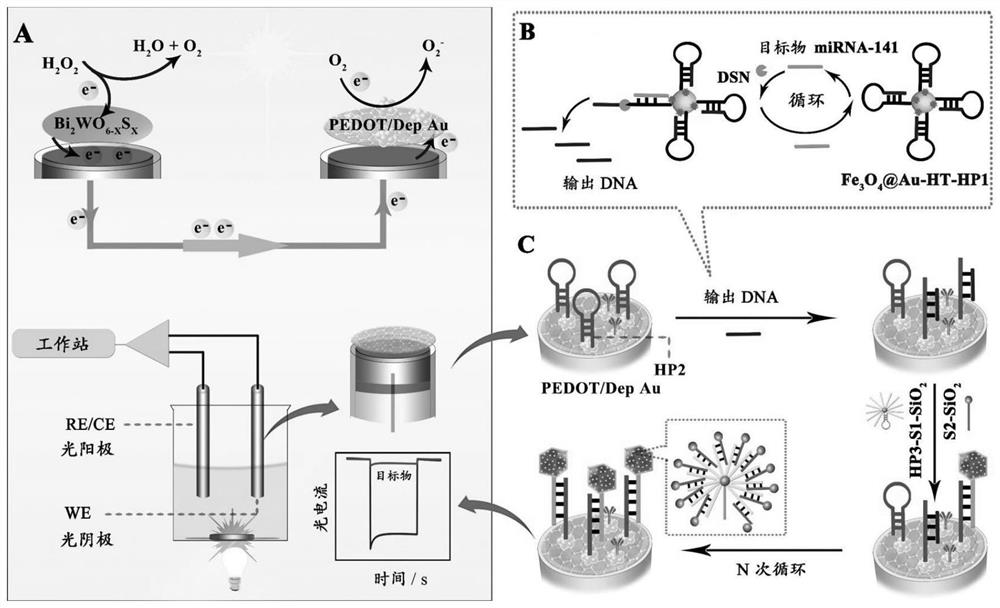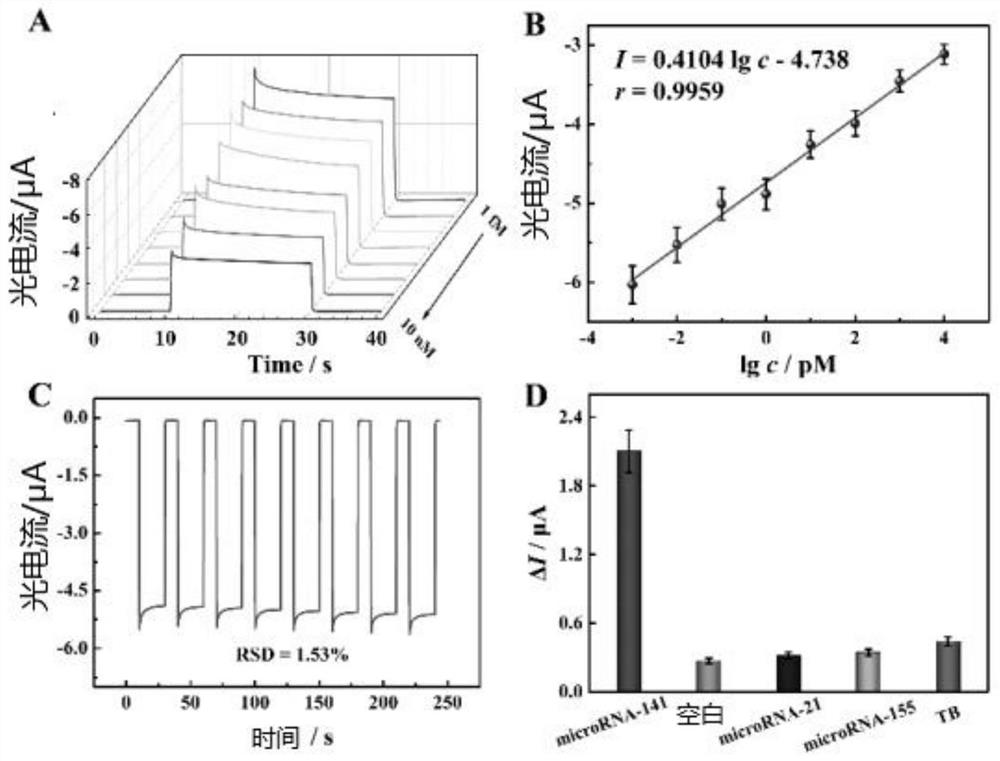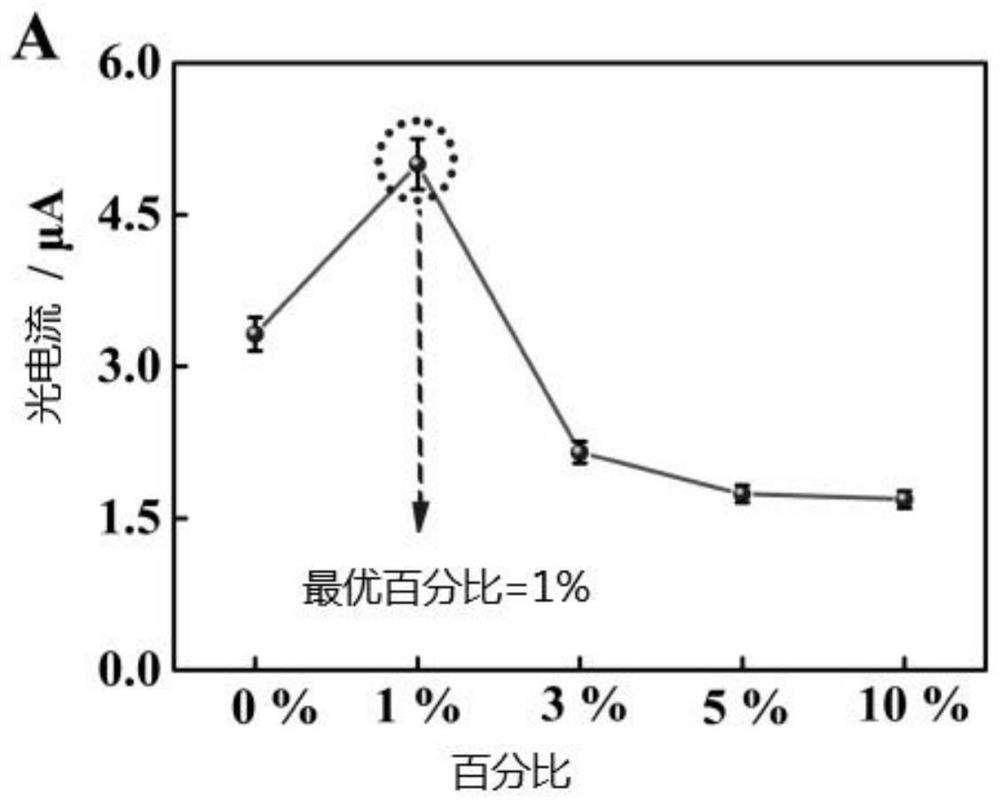Photoinduced electrochemical sensor as well as preparation method and application thereof
A photoelectrochemical and sensor technology, applied in the fields of material electrochemical variables, scientific instruments, instruments, etc., can solve the problems of weak photogenerated electrons, poor conductivity, limited photoelectric conversion efficiency, etc.
- Summary
- Abstract
- Description
- Claims
- Application Information
AI Technical Summary
Problems solved by technology
Method used
Image
Examples
Embodiment 1
[0026] S-doped Bi according to the present invention 2 WO 6 (S:Bi 2 WO 6 ) was prepared by a simple hydrothermal reaction: first, 0.9701 g of hydrated Bi(NO 3 ) 3 Dissolve in 20mL ethylene glycol solution and stir for 30min, while adding 0.3297gNa 2 WO 4 ·2H 2 O was dissolved in 20 mL of ethylene glycol solution with continuous stirring for 30 min, and then the two were mixed and dispersed by ultrasonic until uniform. Then, thiourea was added as a sulfur source to the above mixed solution, and stirring was continued for 1 hour. Finally, the mixed solution was transferred to a 50 mL polytetrafluoroethylene-lined autoclave, and reacted at 180 °C for 24 h in a digitally temperature-controlled reaction furnace. The autoclave was cooled to room temperature naturally, and the gray precipitate was collected by centrifugation, washed several times with distilled water and 95% ethanol, and freeze-dried for use.
[0027] A series of S-doped Bis were synthesized by the same meth...
Embodiment 2
[0034] Construction of the sensor:
[0035] First, the glassy carbon electrode was polished with alumina powder and washed with ethanol and ultrapure water alternately ultrasonically. Next, PEDOT was added dropwise to the surface of the clean and dry glassy carbon electrode, and after being naturally dried to form a film, gold nanoparticles (AuNPs) were deposited on the PEDOT photocathode as a working electrode by electrodeposition. At the same time, S:Bi 2 WO 6 -1% solution was added dropwise to the surface of the same clean and dry glassy carbon electrode, and the photoanode was used as a counter / reference electrode to amplify the photocurrent signal (PEC signal was "on" state), from Figure 4 can be seen.
[0036]Next, the capture chain HP2 of the 5'-modified sulfhydryl group was assembled on the above-mentioned GCE / PEDOT / Dep Au photocathode interface through the Au-S coordination bond. At this time, the non-specific adsorption sites of the cathode interface were blocked ...
Embodiment 3
[0038] 1. The sensor was used to detect the standard solution of miRNA-141. The specific method is as follows:
[0039] 3) miRNA-141-mediated enzyme-assisted cyclic amplification reaction product output DNA formation: First, 120 μL, 2 μM hairpin DNA (HP1) was mixed with Fe 3 O 4 -Au solution was mixed and stirred overnight at 4°C to obtain Fe 3 O 4 -Au-HP1. Subsequently, the mixed solution was magnetically separated and washed and re-dispersed in 120 μL of phosphate buffer solution. 3 O 4 - Hexanethiol was added to the Au-HP1 mixture to block non-specific binding sites. Next, 20 μL miRNA-141, 0.5 μL double-strand-specific nuclease (DSN, 0.1 U) and 0.5 μL 1×DSN master buffer were added to Fe 3 O 4 The -Au-HP1-HT complex continued to react at 60°C for 40 minutes. During this process, the target miRNA-141 can interact with Fe 3 O 4 -HP1 on Au hybridizes to form a DNA-RNA mixed chain, the double-strand specific nuclease can specifically recognize and digest the DNA part ...
PUM
 Login to View More
Login to View More Abstract
Description
Claims
Application Information
 Login to View More
Login to View More - R&D Engineer
- R&D Manager
- IP Professional
- Industry Leading Data Capabilities
- Powerful AI technology
- Patent DNA Extraction
Browse by: Latest US Patents, China's latest patents, Technical Efficacy Thesaurus, Application Domain, Technology Topic, Popular Technical Reports.
© 2024 PatSnap. All rights reserved.Legal|Privacy policy|Modern Slavery Act Transparency Statement|Sitemap|About US| Contact US: help@patsnap.com










